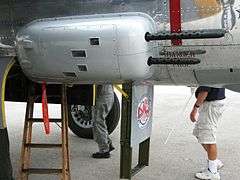Gun pod
A gun pod is a detachable pod or pack containing machine guns, autocannons or rotary cannons and ancillaries, mounted externally on a vehicle such as a military aircraft which may or may not also have its own guns.

Description
A gun pod typically contains one or more guns, a supply of ammunition, and, if necessary, a power source. Electrically powered cannon, such as the M61 Vulcan, may be powered from the aircraft's electrical system or by a ram-air turbine.
Gun pods increase a vehicle's firepower without occupying internal volume. When not required for a specific mission they can be omitted to save weight. On some vehicles they isolate delicate internal components such as radar from the weapon's recoil and gases, and for jet aircraft allow the weapons to be mounted away from the intakes of the engines, reducing problems of gun-gas ingestion, which may cause the engine to stall.
When designed to be suspension-mounted on a hardpoint on a typical post-WW II aircraft, gun pods are inherently less accurate than integral guns, or the type of "conformal" gun pods that are faired smoothly into or onto the nearby surfaces of an aircraft, because the "hardpoint" mounting is necessarily less rigid, so that the weapon's recoil produces more deflection. This problem is particularly acute with powerful cannon like the 30mm GPU-5 gun pod. Both hardpoint-mounted and conformal-mount gun pods also cause substantial drag on fast-moving vehicles such as fighter aircraft.
Gun pods are commonly carried on military helicopters, and are often fitted to light aircraft to equip them for counter-insurgency operations. Some air arms use gun pods for fighter bombers for use in strafing attacks. Since the Vietnam War, United States Air Force policy has been that the use of multimillion-dollar aircraft for strafing is not economically justified, but the Soviet Union, and subsequently Russia, have remained proponents of strafing, and have continued to develop systems for this purpose. Soviet experience in Afghanistan in the 1980s led to an unusual innovation in the form of the SPPU series of gun pods, which have traversable barrels allowing them to continue to fire on a fixed target as the aircraft passes overhead. Lessons learned during the Vietnam War showed the effectiveness of guns. Then expensive fighter jets such as the F-4 didn't even carry an internal cannon. Missiles (thought to be superior) -- in particular radar-guided missiles—had notoriously poor combat track records in air-to-air combat. Engineers and air crews quickly created a solution by attaching rotary cannons in a cut-out fuel drop tank, creating an impromptu gun pod suitable for attacking ground targets (bullets are cheaper than bombs).
World War II

In World War II the Third Reich's Luftwaffe made use of many different, and most often rigidly mounted, conformal and suspended-mount gun pod systems usually called Waffenbehälter (prefix of WB, literally 'weapon container') or Waffenträger (prefix of WT, literally 'weapon carrier'), and carrying anything from rifle caliber MG 81 machine guns, all the way up to the enormous Bordkanone anti-tank cannon based ordnance weapon series, ranging from 37 to 75mm in caliber, though the usual underwing conformal gun pods fitted to Bf 109 and Fw 190 single engined fighters used either the MG 151/20 or MK 108 in gun pod mounts.
Other countries also used gun pods on their aircraft; the U.S. SBD Dauntless could be equipped with two gun pods on each wing, each with two M2 Browning machine guns.
Common gun pods
US
- GPU-2/A: Gun pod with M197 cannon.
- GPU-5/A: Gun pod with GAU-13/A cannon.
- M18/SUU-11/A: Gun pod with M134/GAU-2/A machine gun.
- M12/SUU-16/A: Gun pod with M61A1 cannon.
- M25/SUU-23/A: Gun pod with GAU-4/A cannon.
USSR/Russia
- GUV-8700 Gun Pod (9A624) 2 GShG 7.62mm / 9A622 and 1 Yak-B 12.7mm / 9A624
- GUV-8700 Gun Pod (9A669), similar as above, 1 9A800 (version of AGS-17 30mm automatic grenade launcher) in the same pod.
- UPK-23-250 Gun Pod GSh-23L twin barreled 23mm
- SPPU-22 Depressible Gun Pod GSh-23L twin barreled 23mm
- SPPU-6 Fully Mobile Gun Pod GSh-6-23 six barreled 23mm
- SPPU-687 Depressible Gun Pod (9A-4273) GSh-30-1 high velocity 30mm (prototype)
References
| Wikimedia Commons has media related to Aircraft gun pods. |